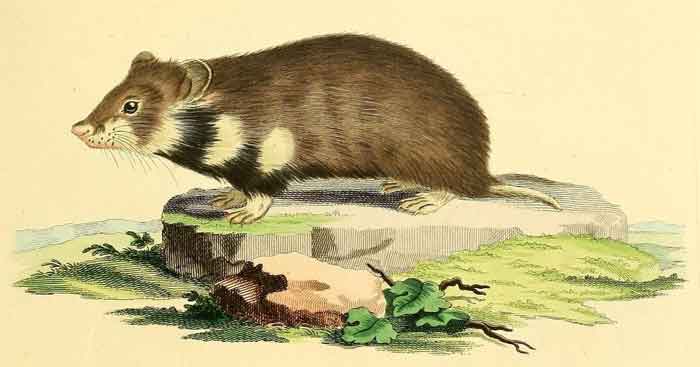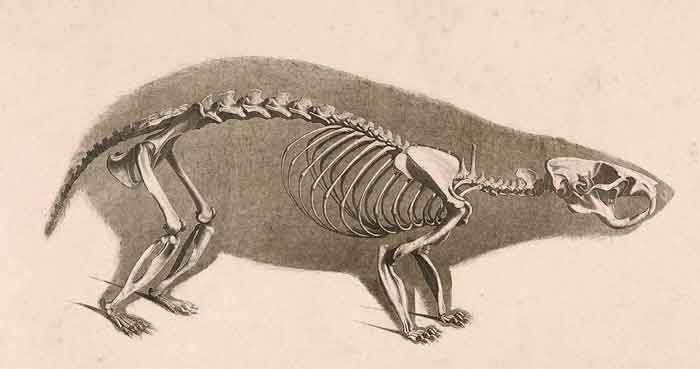
Cricetus cricetus, Photo: Michael Lahanas
Superregnum: Eukaryota
Cladus: Unikonta
Cladus: Opisthokonta
Cladus: Holozoa
Regnum: Animalia
Subregnum: Eumetazoa
Cladus: Bilateria
Cladus: Nephrozoa
Superphylum: Deuterostomia
Phylum: Chordata
Subphylum: Vertebrata
Infraphylum: Gnathostomata
Megaclassis: Osteichthyes
Cladus: Sarcopterygii
Cladus: Rhipidistia
Cladus: Tetrapodomorpha
Cladus: Eotetrapodiformes
Cladus: Elpistostegalia
Superclassis: Tetrapoda
Cladus: Reptiliomorpha
Cladus: Amniota
Cladus: Synapsida
Cladus: Eupelycosauria
Cladus: Sphenacodontia
Cladus: Sphenacodontoidea
Cladus: Therapsida
Cladus: Theriodontia
Cladus: Cynodontia
Cladus: Eucynodontia
Cladus: Probainognathia
Cladus: Prozostrodontia
Cladus: Mammaliaformes
Classis: Mammalia
Subclassis: Trechnotheria
Infraclassis: Zatheria
Supercohors: Theria
Cohors: Eutheria
Infraclassis: Placentalia
Cladus: Boreoeutheria
Superordo: Euarchontoglires
Ordo: Rodentiaa
Subordo: Myomorpha
Superfamilia: Muroidea
Familia: Cricetidae
Subfamilia: Cricetinae
Genus: Cricetus
Species: Cricetus cricetus
Name
Cricetus cricetus (Linnaeus, 1758)
Type locality: Germany
Synonyms
Mus cricetus (protonym)
Heterotypic
Cricetus frumentarius Pallas, 1811
References
Primary references
Linnaeus, C. 1758. Systema Naturae per regna tria naturae, secundum classes, ordines, genera, species, cum characteribus, differentiis, synonymis, locis. Editio Decima, Reformata. Tomus I. Holmiæ (Stockholm): impensis direct. Laurentii Salvii. 824 pp. DOI: 10.5962/bhl.title.542 BHL pages 60–61 BHL Reference page.
Pallas, P.S. 1811. Zoographia Rosso-Asiatica, sistens omnium animalium in extenso Imperio Rossico et adjacentibus maribus observatorum recensionem, domicilia, mores et descriptiones, anatomen atque icones plurimorum. Tomus II. Officina Caesareae Academiae Scientiarum: Petropolis [St. Petersburg]. 374 pp. BnF Gallica Reference page.
Links
Cricetus cricetus in Mammal Species of the World.
Wilson, Don E. & Reeder, DeeAnn M. (Editors) 2005. Mammal Species of the World – A Taxonomic and Geographic Reference. Third edition. ISBN 0-8018-8221-4.
IUCN: Cricetus cricetus (Critically Endangered)
Vernacular names
aragonés: Hámster común
asturianu: Hámster euroasiáticu
беларуская (тарашкевіца): Хамяк звычайны
беларуская: Хамяк звычайны
български: Обикновен хомяк
brezhoneg: Hamster boutin
català: Hàmster comú
čeština: Křeček polní
Deutsch: Feldhamster
English: European Hamster
Esperanto: Kampa hamstro
español: Hámster vulgar
eesti: Hamster
euskara: Europar hamster
suomi: Hamsteri
français: Hamster d'Europe
magyar: Mezei hörcsög
Bahasa Indonesia: Hamster Eropa
italiano: Criceto comune
日本語: クロハラハムスター
Limburgs: Korewouf
lietuvių: Balėsas
latviešu: Eiropas kāmis
Nederlands: Hamster
polski: Chomik europejski
português: Hamster-comum
română: Hârciog
русский: Обыкновенный хомяк
srpskohrvatski / српскохрватски: Evropski hrčak
slovenčina: Chrček poľný
slovenščina: Veliki hrček
српски / srpski: Европски хрчак
svenska: Europeisk hamster
удмурт: Арлан
українська: Хом'як звичайний
中文: 歐洲倉鼠

The European hamster (Cricetus cricetus), also known as the Eurasian hamster,[3] black-bellied hamster[4] or common hamster,[5][6][1] is the only species of hamster in the genus Cricetus.[2] It is native to grassland and similar habitats in a large part of Eurasia, extending from Belgium to the Altai Mountains and Yenisey River in Russia.[7] Historically, it was considered a farmland pest and had been trapped for its fur. Its population has declined drastically in recent years and is now considered critically endangered.[1][8] The main threats to the species are thought to be intensive agriculture, habitat destruction, and persecution by farmers.[1]
Description
Skull of a European hamster

Skeleton
The European hamster has brown dorsal fur with white patches. The chest and belly are black. The tail is short and furred. It is much larger than the Syrian (Mesocricetus auratus) or dwarf hamsters (Phodopus sp.), which are commonly kept as pets, and is the largest known species of hamster. It weighs 220–460 g (7.8–16.2 oz) and can grow to 20–35 cm (8–14 in) long with a tail of 4–6 cm (1.6–2.4 in). Its dental formula is 1.0.0.31.0.0.3. In captivity, the European hamster has an unusually long lifespan for a rodent, living up to eight years.
Behaviour
The common hamster is a nocturnal or crepuscular species. It lives in a complex burrow system. It eats seeds, legumes, root vegetables, grasses and insects. It transports its food in its elastic cheek pouches to the food storage chambers. The storage chambers may be quite large and on average contain 2–3 kg (4.4–6.6 lb) of food, but exceptionally can be up to 65 kg (143 lb).[9][10] It hibernates between October and March. During this time, it wakes every five to seven days to feed from the storage chambers. They are usually solitary animals.[9]
Breeding
The adults reach sexual maturity when they are about 43 days old and breed from early April to August. The gestation period is 18–20 days and the size of the litter ranges from three to 15 young, which are weaned when aged three weeks.
Distribution and habitat
It is typically found in low-lying farmland with soft loam or loess soils, although it may also inhabit meadows, gardens or hedges. It is found from Belgium and Alsace in the west, to Russia in the east, and Bulgaria in the south. A significant population is found in Vienna Central Cemetery in Austria.
Conservation
The Court of Justice of the European Union, the European Union's highest court, ruled in 2011 that France had failed to protect the European hamster.[11] The government would be subject to fines of up to $24.6 million if France did not adjust its agricultural and urbanisation policies sufficiently to protect it.[12][needs update] By 2014, France had started a captive-breeding programme, which aimed to release 500 European hamsters each year into fields that farmers were paid not to harvest.[13]
In 2020, the European hamster was classified as critically endangered across its global range on the IUCN Red List. The reasons for its drastic decline are not fully understood. It has been linked especially to habitat loss due to intensive agricultural practices and the building of roads that fragment populations, and to climate change, the historical fur trapping and to pollution; even light pollution appears to significantly reduce local populations, unless counterbalanced by other factors. Agriculture, development, and persecution are thought to be the biggest threats to the species.[1]
A significant benefit to existing conservation programs is that the European hamster breeds readily in captivity; captive breeding programs for the species exist in Belgium, France, Germany, Poland, Ukraine and elsewhere.[14]
References
Banaszek, A.; Bogomolov, P.; Feoktistova, N.; La Haye, M.; Monecke, S.; Reiners, T. E.; Rusin, M.; Surov, A.; Weinhold, U. & Ziomek, J. (2020). "Cricetus cricetus". IUCN Red List of Threatened Species. 2020: e.T5529A111875852. doi:10.2305/IUCN.UK.2020-2.RLTS.T5529A111875852.en. Retrieved 12 November 2021.
Musser, G. G.; Carleton, M. D. (2005). "Superfamily Muroidea". In Wilson, D. E.; Reeder, D. M. (eds.). Mammal Species of the World: A Taxonomic and Geographic Reference (3rd ed.). Johns Hopkins University Press. p. 1043. ISBN 978-0-8018-8221-0. OCLC 62265494.
"Eurasian hamster". The Free Dictionary. Retrieved 26 April 2013.
"Cricetus Cricetus – Common or Black-Bellied Hamster". AgroAtlas. Retrieved 26 April 2013.
"Common Hamster: Cricetus Cricetus" (PDF). Habitats Directive. European Commission. Retrieved 26 April 2013.
"hamster". Oxford Dictionaries. Oxford University Press. Archived from the original on 6 May 2014. Retrieved 26 April 2013.
"Cricetus cricetus". Animal Diversity Web. University of Michigan. Retrieved 26 April 2013.
Dell'Amore, Christine (18 July 2020). "World's rarest wild hamster is now critically endangered". National Geographic.
MacDonald, David; Priscilla Barret (1993). Mammals of Britain & Europe. Vol. 1. London: HarperCollins. pp. 236–237. ISBN 0-00-219779-0.
Weinhold, U. (8 July 2008), Draft European Action Plan For the conservation of the Common hamster (Cricetus cricetus, L. 1758), Convention on the Conservation of European Wildlife and Natural Habitats, Standing Committee, 28th meeting Strasbourg, 24–27 November 2008
"C-383/09 - Commission v France". InfoCuria. 9 June 2011.
Erlanger, S. (2011). "France Is Scolded Over Care of Great Hamster of Alsace". The New York Times. Retrieved 10 June 2011.
Rauber, P. (2014). "Wild Hamsters of Alsace". Sierra Club. Retrieved 2 July 2020.
"World's rarest wild hamster is now critically endangered". Animals. 16 July 2020. Archived from the original on 26 February 2021. Retrieved 4 December 2022.
Retrieved from "http://en.wikipedia.org/"
All text is available under the terms of the GNU Free Documentation License

